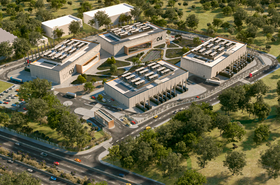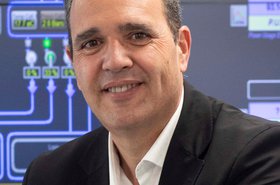Since 2020, there has been an explosion in the data center market across south central Europe – and it’s not set to slow down any time soon.
Between 2022 and 2028, the Central and Eastern European data center construction market is predicted to expand at a compound annual rate of 10.64 percent. This rapid and continual growth is leaving data center operators in the region, including Data4, trying to catch up with a fierce level of demand.
Data4 alone has increased production from around one to three data centers a year to five since 2020. Today, our growth strategy is even more ambitious, with the new aim being to build ten new centers each year.
Geographically, this has seen Data4 double the number of markets in which we operate – from three in 2016 to six in 2023.
But alongside increased capacity, customers expect the service, design, and quality provided by suppliers to remain at the highest standards. And with data centers currently using around three percent of the world’s total energy output, there’s a lot to consider when expanding, particularly in terms of minimizing environmental impact.
Redressing construction methods
To achieve sustainable growth at this level, our priority is providing a quick time-to-market – which new regulations are continually making more complex. Keeping costs as low as possible is also key, but must be married with maintaining a high level of quality – all of this will only be truly successful if we can keep our environmental footprint in check.
We manage this intersection of challenges by sticking to what we call the ‘4 Ps Method’: addressing our Processes, People, Partners, and Production. This has seen us implement innovative digital design processes from the beginning of each project through to construction and beyond.
We work intensively with our human resources department on training and retention programmes. To keep up with consumer demand, Data4 needs to be operating at the highest level of productivity, which means ensuring our staff remain on board and excited about the future.
We are also taking a holistic approach to supply chain review and strategy. To maintain the high standards that we pride ourselves on, and more importantly, that our customers expect, we have a rigorous selection process for all of our suppliers and other partners.
The first stage is ensuring that they meet our competency and financial requirements. But we have also created three redlines that any potential partners must abide by:
- They have to be able to grow alongside us. The resources required to create data centers are limited, and we need to be confident that our suppliers can keep up with our growth.
- Data4 has a strong culture and entrepreneurial direction – any partner we work with must share our values so we can approach issues and solutions from a similar viewpoint.
- To align with our sustainability goals, every partner must at least be assessing a roadmap to reducing their environmental impact.
But the most important way that we have been able to improve our environmental footprint is by addressing our data center production.
Implementing new strategies
We have thoroughly researched where Data4 and the wider data center industry are impacting the environment, and taken stock of where we need immediate and long-term action.
Importantly, we also recognise that our ability to act isn’t static – we have to stay involved with the process, learn how we continue to impact the environment and then readjust our strategy.
This means keeping abreast of technological advances and assessing when it would be possible to apply them to our business. To this end, we have committed to becoming a net zero organization by 2030.
While this may seem odd for one of the largest companies in an industry famed for its sizable energy use, we have already secured a solution to one of the biggest challenges: fuel.
As part of our Operations/Sustainability 22 roadmap, Data4 started exploring the possibility of replacing standard fuel with hydrotreated vegetable oil (HVO). Made from 100 percent renewable resources, HVO is compliant with the EU’s renewable energy directive – and several of our future data centers in France will be operating using it as soon as they come online.
While we are studying the feasibility of rolling HVO out across other territories, we are confident in its ability to help reduce our generators’ carbon footprints by up to 90 percent.
Data4 has also committed to lifecycle analysis for our data centers, and since 2020, this has led to several ground-breaking results. Across our sites, we have drastically reduced the amount of water, in some, replacing it with free cooling methods completely.
We have also found that concrete contributes to a massive 40 percent of our carbon footprint. In response, we launched a low-carbon concrete roadmap, exploring ways of reducing concrete’s environmental impact. The steps we have taken to reduce this have been revolutionary for Data4 and the wider data center industry.
Meeting certifications
In 2019, the Building Research Establishment (BRE) extended its previous data center programme by creating the Data Center Annex Pilot. Since then, every new Data4 data center has been built to these standards.
To achieve BREEAM certification, sustainability goes far beyond just energy efficiency. It also includes nine further requisite criteria: materials, waste, land use, pollution, management, health, wellbeing, transport, and water.
BREEAM certification is now built into every step of the Data4 design process. While we have ten centers that have already earned the new BREEAM data center certification, we have ten more projects in the advanced construction phase, ten at a high level of design, and a further ten we are beginning to develop. This is an ongoing process, and with each new data center, we are achieving improved results, and upping the level of our certification.
Long-term solutions
The data center industry has a responsibility to answer for the social impact it has on the world. Regulatory constraints are helping to reduce environmental impact – and the resulting cost of paying for or offsetting carbon emissions puts further restrictions on how fast the data center industry can go to fill demand.
However, the industry’s energy usage, and the resulting wider environmental imprint, is ultimately a reaction to the needs of society. Data usage is massively expanding – cloud adoption, emerging AI technologies, and the Internet of Things are all modern facets of society that we are becoming increasingly reliant on, and this demand is fuelling the aggressive rate of data center growth.
By reducing supply chains, meeting regulations, and switching to more sustainable resources, data center providers can take tangible steps towards minimizing their environmental footprints.
But to ensure data centers can keep up with the demand for their services, society needs a seismic mindset shift in how it approaches and consumes technology. Perhaps in the future, this will mean putting limits on non-essentials, while prioritising common goods services like transport and healthcare.
For now, however, it is our responsibility as data center providers to do everything we can to be as environmentally friendly as possible, while scaling up to meet the needs of society.
More from Data4
-

Data4 announces second Spanish campus in Madrid
Work on third building at first campus ongoing
-

Sponsored This thriving data center location is ready to take on the market
Data4’s Juan Vaamonde on why it’s time Spain showed the world what it has to offer
-

Sponsored A masterclass in green growth
Data4’s Davide Suppia on the transformation of Italy’s data center landscape


